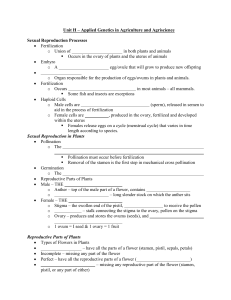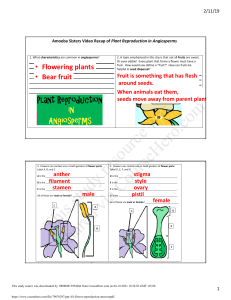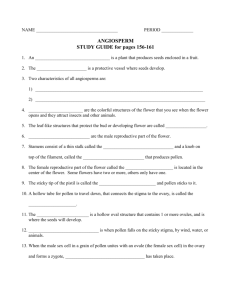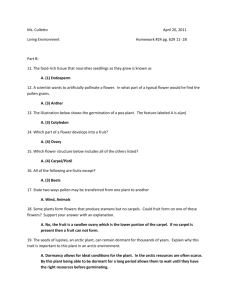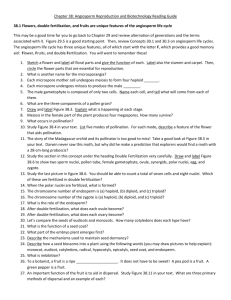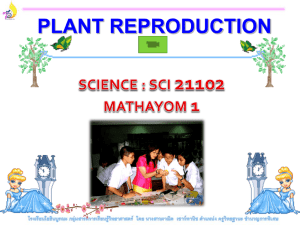Study Guide
advertisement
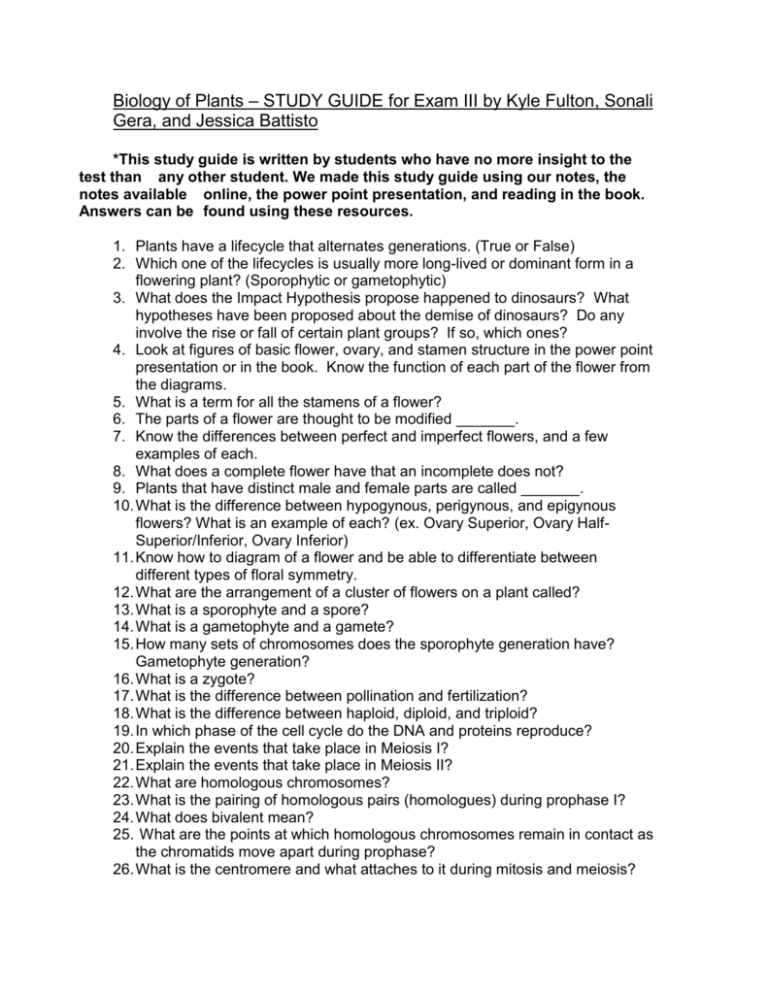
Biology of Plants – STUDY GUIDE for Exam III by Kyle Fulton, Sonali Gera, and Jessica Battisto *This study guide is written by students who have no more insight to the test than any other student. We made this study guide using our notes, the notes available online, the power point presentation, and reading in the book. Answers can be found using these resources. 1. Plants have a lifecycle that alternates generations. (True or False) 2. Which one of the lifecycles is usually more long-lived or dominant form in a flowering plant? (Sporophytic or gametophytic) 3. What does the Impact Hypothesis propose happened to dinosaurs? What hypotheses have been proposed about the demise of dinosaurs? Do any involve the rise or fall of certain plant groups? If so, which ones? 4. Look at figures of basic flower, ovary, and stamen structure in the power point presentation or in the book. Know the function of each part of the flower from the diagrams. 5. What is a term for all the stamens of a flower? 6. The parts of a flower are thought to be modified _______. 7. Know the differences between perfect and imperfect flowers, and a few examples of each. 8. What does a complete flower have that an incomplete does not? 9. Plants that have distinct male and female parts are called _______. 10. What is the difference between hypogynous, perigynous, and epigynous flowers? What is an example of each? (ex. Ovary Superior, Ovary HalfSuperior/Inferior, Ovary Inferior) 11. Know how to diagram of a flower and be able to differentiate between different types of floral symmetry. 12. What are the arrangement of a cluster of flowers on a plant called? 13. What is a sporophyte and a spore? 14. What is a gametophyte and a gamete? 15. How many sets of chromosomes does the sporophyte generation have? Gametophyte generation? 16. What is a zygote? 17. What is the difference between pollination and fertilization? 18. What is the difference between haploid, diploid, and triploid? 19. In which phase of the cell cycle do the DNA and proteins reproduce? 20. Explain the events that take place in Meiosis I? 21. Explain the events that take place in Meiosis II? 22. What are homologous chromosomes? 23. What is the pairing of homologous pairs (homologues) during prophase I? 24. What does bivalent mean? 25. What are the points at which homologous chromosomes remain in contact as the chromatids move apart during prophase? 26. What is the centromere and what attaches to it during mitosis and meiosis? 27. Know the different positions of the centromere. (metacentric, acrocentric, and telocentric) 28. Know the phases of Meiosis I. 29. What are the names of the substages of Prophase I? 30. What is one way that genetic recombination occurs? 31. Know the phases of Meiosis II? 32. What is a microspore and what is process through which it is produced? 33. What is a megaspore and what is process through which it is produced? 34. What happens after pollination in a plant? Know ways in which pollination can occur. (Wind...) 35. Be able to recognize the parts of the plant involved in pollination and fertilization of a plant. (Pollen Tube, Micrpyle…) 36. Gametogenesis is a result of mitosis occurring within the body of the pollen grain and the embryo sac. 37. What is found within a pollen grain? 38. Most plants have double fertilization: True or False 39. What does double fertilization produce? 40. What are carpels? 41. What is the difference between a simple and compound carpel or pistil? 42. What does a ripened fruit of an angiosperm contain? 43. What are the three layers of the pericarp? 44. Know some examples of plants with different types of fleshy and dry fruit types: berry, drupe, pepo, hesperidium, pome, capsule, sislique, follicle, legume, caryopsis, samara, nut, achene, aggregate fruit, and multiple fruit. 45. What gives the embryo of a plant the nutrition it needs? 46. What develops into the seed coat of a seed? 47. What are the two main groups of angiosperms and what are the differences between them? 48. What are the key adaptations in the evolution of angiosperms? 49. Know the life cycle for a typical angiosperm. 50. What is an example of a flower with regular symmetry? With irregular symmetry? 51. What plant part makes up the edible parts of fruits like grapefruit and tomato? 52. True or False Destruction of habitats and disruption of habitats by common and native species threaten plant diversity. 53. Products from seed plants include food, wood, and many _____________. 54. What is the calyx? 55. What happens during the phases of Prophase I? 56. What is another name for the ripened ovary? 57. What is the difference between an aggregate and a multiple fruit? Can you give an example of each type? 58. What is the difference between a berry and a drupe? 59. Can a flower be incomplete and perfect at the same time?




